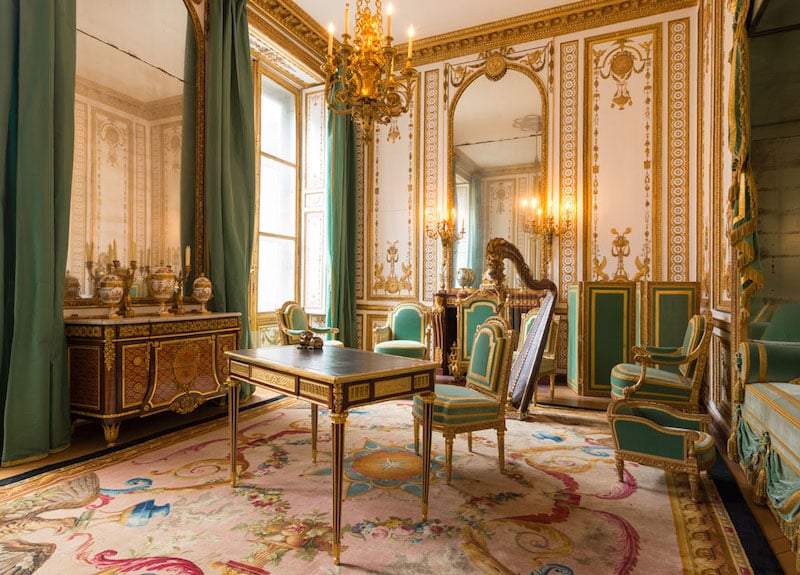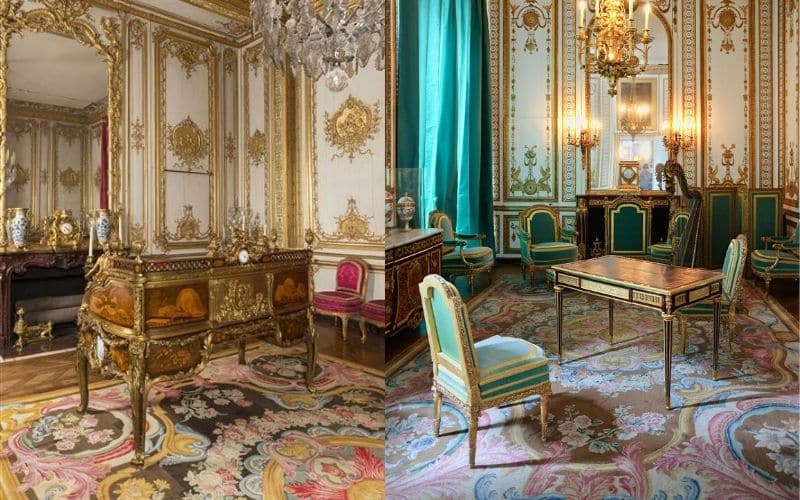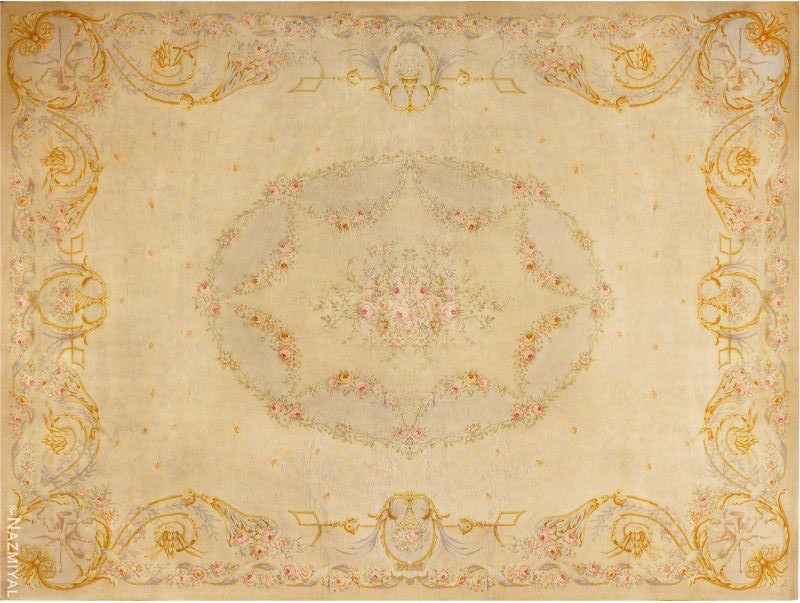Learn More About The Palace Of Versailles and Its Beautiful Rugs and Carpets
Shop All French Rugs | Shop All French Aubusson Rugs | Shop All Savonnerie Rugs | Shop All Tapestry Collection
Shop All Antique Rugs | Shop All Vintage Rugs | Shop All Modern Rugs | Create Your Own Versailles Inspired Custom Rugs
The Story Of The Palace of Versailles Rugs and Carpets
Versailles Rugs – The Court of Louis XIV of France left an indelible mark on the world of fashion and home furnishing. He was known as the “Sun King,” and reigned for an impressive 72 years. During those years, style and fashion became a sign of outward wealth and status. Out of this quest to show his wealth came some of the most beautiful carpets and tapestries of the era.
Intro To The Palace Of Versailles
Step into a world of opulence and grandeur as we delve deeper into the history of the Palace of Versailles, a timeless symbol of French magnificence. Originally a modest hunting lodge nestled in the serene countryside, Versailles underwent a remarkable transformation under the visionary reign of Louis XIV, evolving into the epitome of royal splendor.
During the 17th century, Louis XIV commissioned the finest architects and artisans to expand and embellish the palace, crafting a masterpiece of Baroque architecture that would captivate generations to come. From the majestic Hall of Mirrors, with its dazzling reflections and ornate gilding, to the meticulously landscaped gardens adorned with marble statues and cascading fountains, Versailles epitomized the grandeur and power of the French monarchy.

Palace Versailles Rugs and Carpets
As the seat of political power and cultural refinement, Versailles flourished as a hub of artistic and intellectual exchange, attracting luminaries from across Europe. The palace resonated with the melodies of court musicians, the brilliance of theatrical performances, and the vibrant discussions of philosophers and poets.
However, the winds of change swept through Versailles with the onset of the French Revolution in 1789. The palace, once a symbol of absolute monarchy, became a focal point of revolutionary fervor as the people of France demanded liberty, equality, and fraternity. The tumultuous events of the revolution marked the end of the royal era at Versailles, ushering in a new chapter in its storied history.
Yet, even amidst the upheaval of revolution, the legacy of Versailles endured. In 1919, the palace witnessed a pivotal moment in world history as it hosted the signing of the Treaty of Versailles, bringing an end to the devastation of World War I.
Today, the Palace of Versailles stands as a testament to the enduring allure of French culture and heritage. Its halls echo with the footsteps of millions of visitors who come to marvel at its beauty and immerse themselves in its rich history. And woven into the fabric of this illustrious palace are exquisite rugs and carpets, each bearing witness to centuries of elegance and refinement.
Join us on a journey through the halls of Versailles as we explore the intricate tapestries, sumptuous carpets, and luxurious rugs that adorn its magnificent interiors. Discover the stories woven into these masterpieces, from the skilled hands that crafted them to the illustrious figures who once walked upon them. Let us unravel the threads of history and beauty that make Versailles truly timeless.
What does Versailles mean?
The name “Versailles” is derived from the French words “verser” (to pour) and “sailles” (planks), which refer to the marshy land on which the Palace of Versailles was built. In the 17th century, the area was known for its forests and hunting grounds, and King Louis XIII had a hunting lodge there. Later, King Louis XIV transformed the lodge into the magnificent palace we know today, and the surrounding town and region took on the name Versailles.
What is Versailles famous for?
Versailles, a city located just outside Paris, France, is primarily famous for the Palace of Versailles. This grandiose palace was originally a hunting lodge before being transformed into one of the most opulent royal residences in the world by King Louis XIV in the 17th century. Versailles Palace is renowned for its stunning architecture, lavish gardens, and its historical significance as the center of political power in France during the reign of Louis XIV and subsequent monarchs.
It also holds significance as the site where the Treaty of Versailles was signed in 1919, officially ending World War I. Today, Versailles attracts millions of visitors annually who come to admire its beauty, explore its history, and experience the splendor of the French monarchy.
What is so special about the palace of Versailles?
The Palace of Versailles is special for several reasons:
- Architectural Grandeur: It is one of the finest examples of French Baroque architecture, renowned for its symmetry, opulence, and grandeur. The palace’s architecture, designed by architects such as Louis Le Vau and Jules Hardouin-Mansart, is breathtaking, featuring ornate facades, elaborate interiors, and majestic halls.
- Historical Significance: Versailles was the principal residence of French kings and queens from Louis XIV to Louis XVI. It served as the center of political power in France for over a century, symbolizing the absolute monarchy and the wealth and authority of the French crown.
- Gardens and Park: The palace is surrounded by extensive formal gardens and a vast park, meticulously landscaped by renowned landscape architect André Le Nôtre. The gardens feature ornamental ponds, fountains, statues, and meticulously manicured lawns, offering a picturesque backdrop to the palace.
- Hall of Mirrors: One of the most famous features of the palace is the Hall of Mirrors (Galerie des Glaces), a magnificent gallery adorned with seventeen mirrored arches reflecting the adjacent windows and providing stunning views of the gardens. The hall was the setting for important events in French history, including the signing of the Treaty of Versailles in 1919.
- Art and Decor: The palace houses an extensive collection of art, furniture, and decorative objects, showcasing the finest craftsmanship and artistic achievements of the period. Visitors can admire exquisite paintings, sculptures, tapestries, and furnishings throughout the palace.
- Cultural Legacy: Versailles has left an enduring legacy on French culture and history, influencing art, architecture, and society. It continues to attract millions of visitors from around the world who come to marvel at its beauty, learn about its history, and experience the splendor of the French monarchy.
What is the history of the palace of Versailles?
The history of the Palace of Versailles is rich and multifaceted:
- Early History: The site of Versailles was originally a hunting lodge built by Louis XIII in the early 17th century. His son, Louis XIV, developed a fondness for the area and decided to transform the hunting lodge into a grand palace.
- Expansion under Louis XIV: In 1661, Louis XIV commissioned extensive renovations and expansions of the palace, entrusting architects such as Louis Le Vau and Jules Hardouin-Mansart with the task. Over the next several decades, the palace grew into a magnificent complex, with grand apartments, ceremonial halls, and sprawling gardens.
- Symbol of Absolute Monarchy: Versailles became the principal residence of the French monarchy and the seat of political power in France. Louis XIV famously centralized power around himself and his court at Versailles, establishing a highly ritualized court culture that emphasized his absolute authority.
- Cultural Center: Versailles served as a cultural center, attracting artists, musicians, writers, and intellectuals from across Europe. The palace hosted lavish balls, concerts, and theatrical performances, contributing to the flourishing of French arts and culture during the 17th and 18th centuries.
- Expansion and Renovations: Successive monarchs, including Louis XV and Louis XVI, made further additions and renovations to the palace and its gardens. The Hall of Mirrors, one of Versailles’ most iconic features, was completed during the reign of Louis XIV.
- French Revolution: The French Revolution of 1789 brought an end to the monarchy and the royal court at Versailles. In 1789, revolutionaries stormed the palace, forcing King Louis XVI and Queen Marie Antoinette to return to Paris. The revolutionaries subsequently declared Versailles a national property and transformed it into a museum.
- Treaty of Versailles: In 1919, the Palace of Versailles gained further historical significance when it hosted the signing of the Treaty of Versailles, which formally ended World War I. The treaty was signed in the Hall of Mirrors, symbolizing the end of one of the deadliest conflicts in history.
- Tourist Destination: Today, the Palace of Versailles is one of the most visited tourist attractions in the world, attracting millions of visitors each year who come to admire its architecture, gardens, and historical significance. It remains a symbol of France’s rich cultural heritage and its storied history.
Fashion and the Court at Versailles
Louis XIV style arose to complement the massive building projects taking place around Paris. The Court at Versailles was intended to inspire awe with its grand style of architecture. Furniture, paintings, carpets, and draperies were designed to highlight the appearance of massive scale. The style emphasized a richness of materials that included the most expensive fabrics, bronze, stone, and marble.
This style required the creation of extravagant carpets to match – and here is where the iconic Palace of Versailles rugs and carpets were born. At that time, wares from the Orient and Near East were a sign of status. Furniture sat perched on ornate cabriole legs, allowing it to show off the fine carpets that were underneath.

Marie Antoinette’s apartment with rug at Versailles.
During the time of Louis XIV, royalty dictated what to wear and what not to wear. The earlier years were dominated by dark fabrics and elaborate designs. By the end of the reign in 1715, the style became lighter and used more pastels.
It was a time when fashion was dominated by frills, bows, lace, and ruffles. The architecture was dominated by frescoes, ornate reliefs, and stately columns. This style was reflected in the carpets of the time, too. It might be noted that it was fashionable at the time to hang Savonnerie carpets from the ceiling, as well as displaying them on the floors and walls.

Versailles Aubusson
Savonnerie Workshops
The Savonnerie workshops were the forerunner of the Aubusson workshops. They got their start under King Henry IV of France between 1589 and 1610. The reason for the establishment of the workshops is that King Henry became alarmed by the depletion of the national treasury due to the need to import Oriental carpets and other luxury goods. He decided to set up the manufacture of fine carpets in France in an attempt to compete with imports. The primary motive was to keep French silver remaining within its borders.
The first Savonnerie workshop was set up in the Louvre Palace itself by Pierre DuPont. King Louis XIII granted DuPont an 18-year monopoly for making carpets. Savonnerie carpets were made from wool and used the Ghiordes, or Turkish knot. They were about 90 knots per square inch, on average. In the beginning, they were copies of Persian and Turkish rugs, but they eventually developed their own distinctive style based on classical Roman designs. They featured dense flowers, leaves, and vine work.
They often included the armorials of the noblemen who commissioned them. They were characterized by deep blue, black, and brown backgrounds with bright designs. The Savonnerie workshops operated from around 1650-1789.

Large Floral Antique French Savonnerie Carpet
The Aubusson Workshop
In 1662, the Gobelin tapestry workshop was purchased to create fine tapestries for the courts, but they had competition. The privately-owned Beauvais Manufactory and Aubusson tapestry workshop already produced similar works. The Aubusson workshop produced both wall tapestries and carpets. Prior to 1665, the designs of Aubusson carpets were based on Turkish examples, but after around 1665, they were based on Savonnerie carpets due to the end of the monopoly granted to DuPont and the Savonnerie workshops. Prior to this time, Savonnerie carpets were only available to the royal courts.
Aubusson carpets were works of art and matched the opulent style that was in fashion at the time. Favorite colors included light blue, rose, and ivory. Aubusson carpets used more subtle color combinations than their Savonnerie predecessors. They included floral, architectural, and geometric designs that were often highly ornate. The Aubusson workshop operated until 1870 when it shut down.
Rococo Style Of Palace Versailles Rugs and Carpets
The Rococo style began in the 1730s as an answer to the formal, geometric style of Louis XIV. It generally refers to the time of Louis XV, which is considered to have ended around 1750. Rococo style is characterized by a highly theatrical and dramatic level of decoration and complexity. Whereas Louis XIV style tended to be on a grand scale and emphasize space, Rococo style as about the fine details. Angular lines gave way to soft curves and delicate textures. Therefore it is no surprise the the Palace Versailles rugs and carpets were woven in the Rococo style.

Rococo Style Interior Design With Persian Rug
In 1722, the Afghans invaded Persia, and all carpet imports from the area stopped being available to the European market. At that time, the Savonnerie workshop had been established for about 100 years. This provided an opportunity for them to fill the gap. They produced carpets that complemented the Rococo style with designs that became increasingly lavish and decadent. The looms at Aubusson began to create carpets with distinctive Rococo style scrollwork. Both the Savonnerie workshops and Aubusson would occasionally continue to produce carpets with a distinctive Persian influence or design element. This design never completely went out of style.
The time of Louis XIV and Louis XV was a time of excesses when it came to fashion and interior design. The looms of Aubusson and Savonnerie competed for the business of the upper class. During this time, they created some of the most beautiful and ornate designs of any European manufacturers. Their designs are distinctive and easily recognized. Many of them are copied by modern designers, but the originals are a rare antique that is highly prized by collectors.
We invite you to browse our excellent selection of Aubusson and Savonnerie designs. They make the perfect complement to formal interior designs. They are elegant and have a distinctive presence in the room. If you find one that is too beautiful to resist, our friendly and knowledgeable staff would be happy to assist.
This post about the Palace Versailles rugs and carpets was published by Nazmiyal Rugs and Carpets



